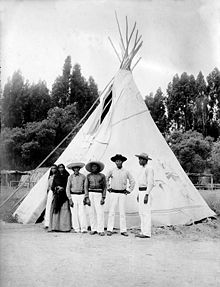Battle of Bear Valley: Difference between revisions
Fullobeans (talk | contribs) "Red Indian", to my knowledge, is archaic; "Indian" needs no qualifiers in context |
Matt Gerber (talk | contribs) m typos |
||
| Line 30: | Line 30: | ||
[[Image:Yaqui indians.jpg|thumb|right|Yaqui people, c1910]] |
[[Image:Yaqui indians.jpg|thumb|right|Yaqui people, c1910]] |
||
On [[January]] 9, 1918, a small force of U.S. 10th Cavalry soldiers detected a band of over two dozen [[Yaqui]]s, hiking up to their camp. At some point the Yaquis discovered the advancing Americans and hastily began to |
On [[January]] 9, 1918, a small force of U.S. 10th Cavalry soldiers detected a band of over two dozen [[Yaqui]]s, hiking up to their camp. At some point the Yaquis discovered the advancing Americans and hastily began to withdraw, leaving behind ten men to protect their retreat. The U.S. Cavalry stopped and then dismounted. The American's orders were [[simple]], deny the Yaquis their [[base]] by advancing and capturing the Yaqui camp. Now on foot the cavalrymen proceeded up to the camp. Once in range the Yaquis opened fire with minimal accuracy, then did the Americans. Under fire and firing back, the U.S. Army moved forward. For thirty minutes the two forces fought in the classic [[Indian War]] style. Both sides used the natural defenses for cover, instead of charging into each other right away. Eventually the Yaquis [[Surrender (military)|surrender]]ed. This after their [[tribal chief|chief]] was wounded in the chest when a bullet hit his ammo cartridges, thus exploding and leaving an open wound.<ref name="hood"/> |
||
==Aftermath== |
==Aftermath== |
||
Revision as of 23:58, 4 December 2009
| Battle of Bear Valley | |||||||
|---|---|---|---|---|---|---|---|
| Part of the American Indian Wars Mexican Revolution | |||||||
 A sunset in Southern Arizona. | |||||||
| |||||||
| Belligerents | |||||||
|
|
| ||||||
| Commanders and leaders | |||||||
| Blondy Ryder | unknown | ||||||
| Strength | |||||||
|
unknown, estimate: 30 |
unknown, estimate: 30 | ||||||
| Casualties and losses | |||||||
| unknown wounded | 1 killed, unknown wounded | ||||||
The Battle of Bear Valley was a small engagement between the revolutionary Yaqui natives and the United States Army on January 9, 1918 in Southern Arizona.[1]
Background
For years the Yaqui Native Americans were fighting the Mexicans for an independent state in Northern Mexico. In 1918 the fight was still at hand. Yaquis, being poor peasants, would smuggle themselves across the border into Arizona, where they traveled to Tucson to find work in the orange groves. Upon payment, the Yaquis would purchase weapons and return to Mexico to fight their war. In 1917, American farmers and ranchers began reporting their sightings of armed Indians and butchered livestock, found in their grazing ranges. This prompted the US Army to conduct border patrols in the area. Yaqui natives had constructed a base in Bear Valley, along trails widely used by travelers passing to and from Mexico. The natives positioned their camp on a ridge overlooking Bear Valley.[1]
Battle

On January 9, 1918, a small force of U.S. 10th Cavalry soldiers detected a band of over two dozen Yaquis, hiking up to their camp. At some point the Yaquis discovered the advancing Americans and hastily began to withdraw, leaving behind ten men to protect their retreat. The U.S. Cavalry stopped and then dismounted. The American's orders were simple, deny the Yaquis their base by advancing and capturing the Yaqui camp. Now on foot the cavalrymen proceeded up to the camp. Once in range the Yaquis opened fire with minimal accuracy, then did the Americans. Under fire and firing back, the U.S. Army moved forward. For thirty minutes the two forces fought in the classic Indian War style. Both sides used the natural defenses for cover, instead of charging into each other right away. Eventually the Yaquis surrendered. This after their chief was wounded in the chest when a bullet hit his ammo cartridges, thus exploding and leaving an open wound.[1]
Aftermath

No Americans were killed that day but some were reported to have minor injuries. The Yaquis surrendered and were subsequently captured, one of which was a ten year old boy. The U.S. Army gave aid to the wounded natives. On their way back to Nogales, the Yaqui chief died of his injury. The rest of the natives, except for the boy, were taken back and put in jail on charges of gun smuggling and other crimes. All of which were considered minor in those days. Some of the natives spent a few weeks in jail but were eventually released. When asked why the Yaquis fired on the approaching Americans, they replied by saying they thought that the American buffalo soldiers involved were Mexicans, coming to attack them. The small battle marks the last engagement between the United States Army and native Americans, thus ending the American Indian Wars.[1]
Sources
- (website): Finley, James P. Huachuca Illustrated Vol. 2 Part 5, Buffalo Soldiers at Huachuca: Yaqui Fight in Bear Valley. Library of Congress 1996, ISBN 93-206790
- (website): 10th Cavalry Squadron History
References
- ^ a b c d "10th Cavalry Squadron History". US Army.
